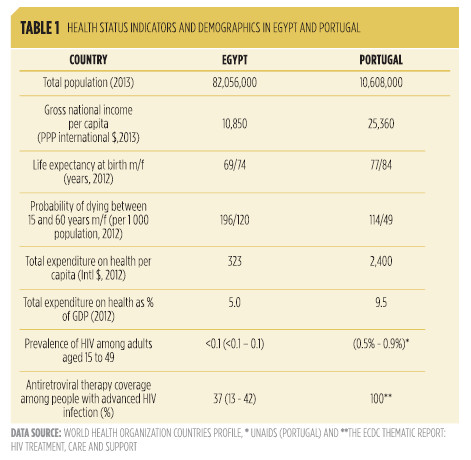Services on Demand
Journal
Article
Indicators
-
 Cited by SciELO
Cited by SciELO -
 Access statistics
Access statistics
Related links
-
 Similars in
SciELO
Similars in
SciELO
Share
Arquivos de Medicina
On-line version ISSN 2183-2447
Arq Med vol.29 no.3 Porto June 2015
CARTA AO EDITOR
HIV across two continents: comparison between Egypt and Portugal
Ahmed Nabil Shaaban1,2,3
1Department of Clinical Epidemiology, Predictive Medicine and Public Health, University of Porto Medical School, Porto, Portugal
2 Institute of Public Health, University of Porto, Porto, Portugal
3 The Public Health Center of West of Nasr City, Cairo, Ministry of Health of Egypt
Key-words: human immunodeficiency virus, high-risk groups, Egypt, Portugal
Dear Editor,
Human immunodeficiency virus (HIV) infection is one of the main public health concerns in Africa, Europe and the whole world. The new Millennium Development Goals (MDGs) 2015 ‘Getting to Zero' aim to build a world without the acquired immune deficiency syndrome (AIDS) and to put preventive strategies for HIV infection.1 In this letter to the editor, I would like to compare between the epidemic of HIV in Egypt as a representative of North of Africa and in Portugal as a representative of West of Europe.
Although the considerable health improvements in Portugal in recent decades2 and despite adopting many measures to improve the performance of the Portuguese healthcare system, including the reorganization of primary care and setting a long term care networks,2 HIV infection continues to be of major public health importance in the country (Table 1).

In 2013, 4,369 cases of AIDS were diagnosed and reported by 29 EU/EEA countries, with a rate of 0.9 cases/100000 population. The highest rates were diagnosed and reported by Latvia (6.6) and then by Portugal (3.1).3 In Portugal, as a part of West of Europe, the HIV epidemic is highly concentrated in three sub-groups: men who have sex with men, injecting drug users and migrants (specifically migrants from high HIV prevalence countries).4 The prevalence of HIV among adults can reach up to 0.9%.5
On the other hand, the epidemic of HIV in Egypt is quite different. Egypt, as a country from The Middle East and North Africa (MENA) region, has one of the lowest HIV prevalence rates in the world (0.1%).6 Number of HIV cases remains low in Egypt, around 7,400 [4,800-12,000].7 Although a low-prevalence region, and similar to Portugal, there is evidence that the Egypt is witnessing growing epidemics among most at-risk populations (MARPs), with HIV infection more than 5% among people who inject drugs (PWID) and men who have sex with men.7,8
Linkages between most at-risk groups and the general population highlight the crucial need to increase the awareness and sensitize Egyptians about HIV infection to prevent further transmission.7 In Egypt, about 70% of the HIV infection transmission occurs through sexual relations.7 Infection through injecting drug use, blood and mother-to-child transmission are all below 5%. However, infection through renal dialysis and cases where the mode of infection is unknown each represent about 9% of detected cases.7
Unlike Portugal, the stigma of HIV is extremely exaggerated in Egypt. The burden of these attitudes is heavy in a conservative country like Egypt.9 The stigma and discrimination of HIV are the most serious challenges to confront the disease in Egypt.10 Many people, including the medical personnel, despise the patients because they see them as doing abnormal lifestyles.10 Fear of stigma and discrimination keeps HIV positive patients from seeking counseling, treatment for AIDS, or from disclosing their HIV status.9
To conclude, it's easy to notice that the global health is still under threat due to the pandemic of HIV. There is an urgent need to establish a tailored surveillance and epidemiological methods and tools especially for high-risk groups. It's important to build new programs, reforms and polices to have an effective intervention, including the biomedical interventions such as pre-exposure prophylaxis for HIV in high-risk populations. There is an important need to give the proper feedback to the health policy makers and to translate gaps from the stage of evidence to the stage of policy and practice. Interventions to encounter stigma and discrimination, especially in Egypt, require a community dialogue that involves policy makers, healthcare personnel, public figures and people who are living with HIV.
Acknowledgement
I would like to express my special thanks to Professor Henrique Barros for his inspiring role, and I would like to thank Professor Raquel Lucas, Ana Martins and Paula Meireles for the guidance, Professor Barbara Peleteiro for this opportunity, and for the support from all the staff of the Institute of Public Health of University of Porto.
References
1. MDG 6: combat HIV/AIDS, malaria and other diseases: The World Health Organization. Available from: http://www.who.int/topics/millennium_development_goals/diseases/en/. [ Links ]
2. Barros PP, de Almeida Simões J, Allin S, Mossialos E. Health Systems in transition. Health. 2007;9(5). [ Links ]
3. European centre for Disease Prevention and control/ WHO Regional Office for Europe. HIV/AIDS surveillance in Europe 2013. Stockholm: European centre for Disease Prevention and control; 2014. [ Links ]
4. WHO, UNICEF. Global report: UNAIDS report on the global AIDS epidemic 2013. Geneva: UNAIDS. 2013. [ Links ]
5. Portugal: HIV and AIDS estimates (2012): UNAIDS. Available from: http://www.unaids.org/en/regionscountries/countries/portugal. [ Links ]
6. Egypt: HIV and AIDS estimates (2013): UNAIDS. Available from: http://www.unaids.org/en/regionscountries/countries/egypt. [ Links ]
7. Egypt: HIV/AIDS: UNICEF. Available from: http://www.unicef.org/egypt/hiv_aids.html. [ Links ]
8. Mumtaz G, Hilmi N, McFarland W, Kaplan RL, Akala FA, Semini I, et al. Are HIV epidemics among men who have sex with men emerging in the Middle East and North Africa?: a systematic review and data synthesis. PLoS medicine. 2010;8(8):e1000444. [ Links ]
9. Morrow A, ed. Combating HIV/AIDS related stigma in Egypt: situation analysis and advocacy recommendations. [ Links ]
10. Egypt: HIV-positive people battle health service discrimination: IRIN; 2011. Available from: http://www.irinnews.org/report/93624/egypt-hiv-positive-people-battle-health-service-discrimination. [ Links ]
Ahmed Nabil Shaaban
Instituto de Saúde Pública da Universidade do Porto (ISPUP). Rua das taipas, 135, 4050-600 Porto, Portugal. E-mail: dr.ahmed_nabil@hotmail.com
Data de recepção / reception date: 11/02/2015
Data de aprovação / approval date: 13/02/2015














